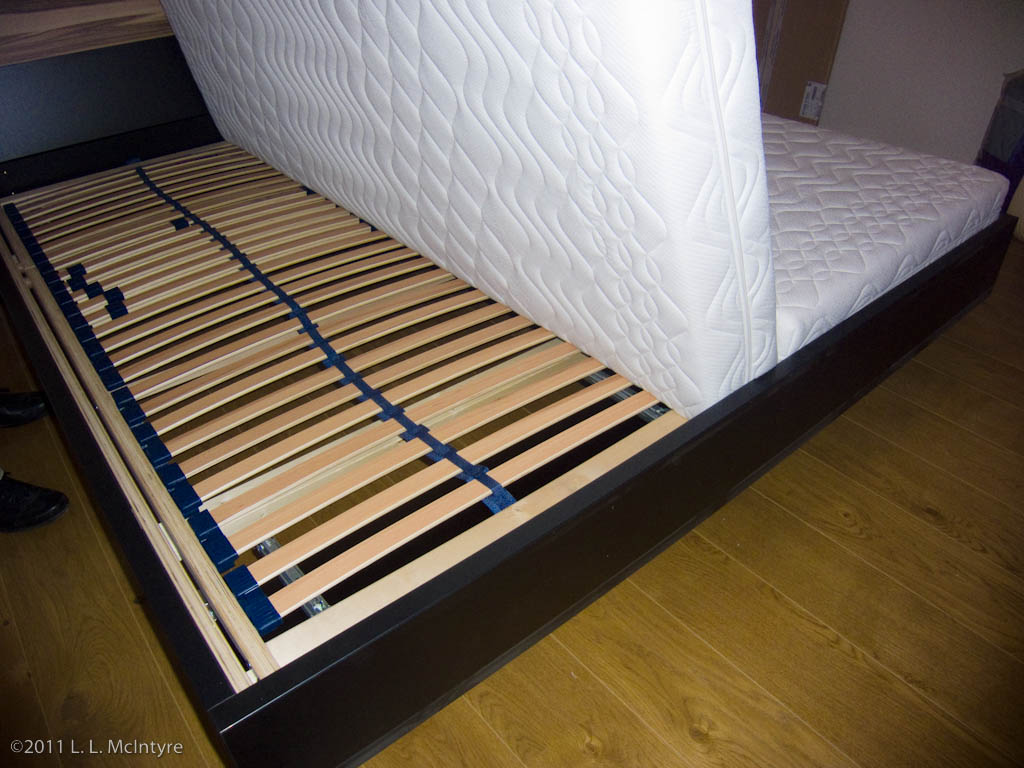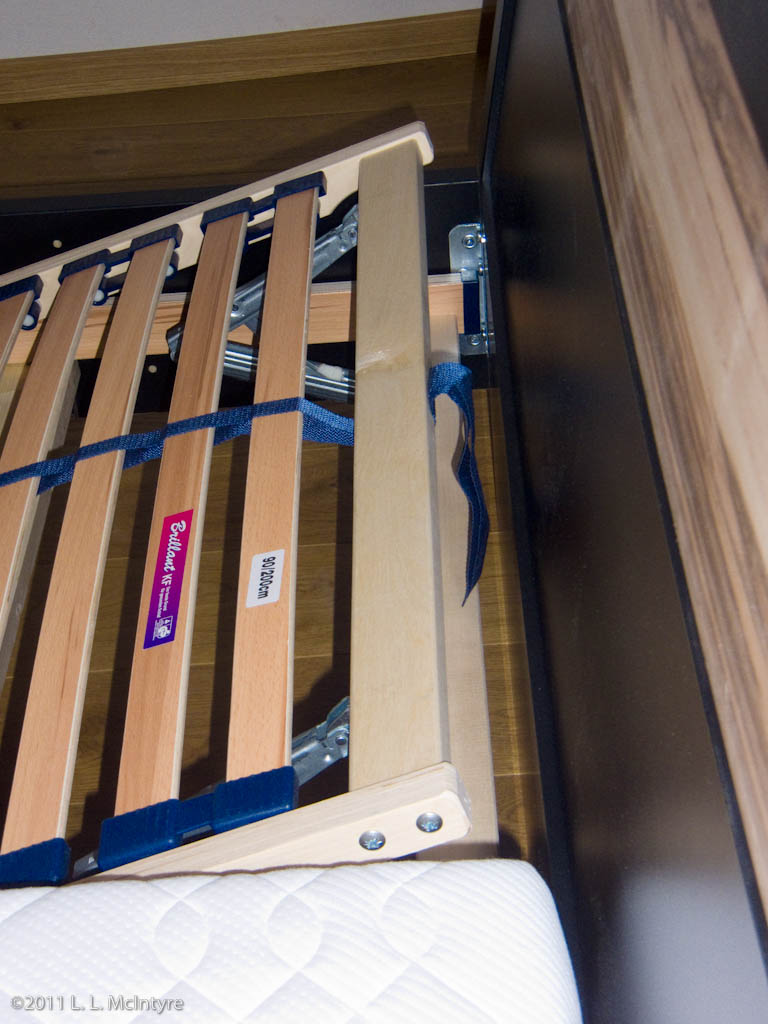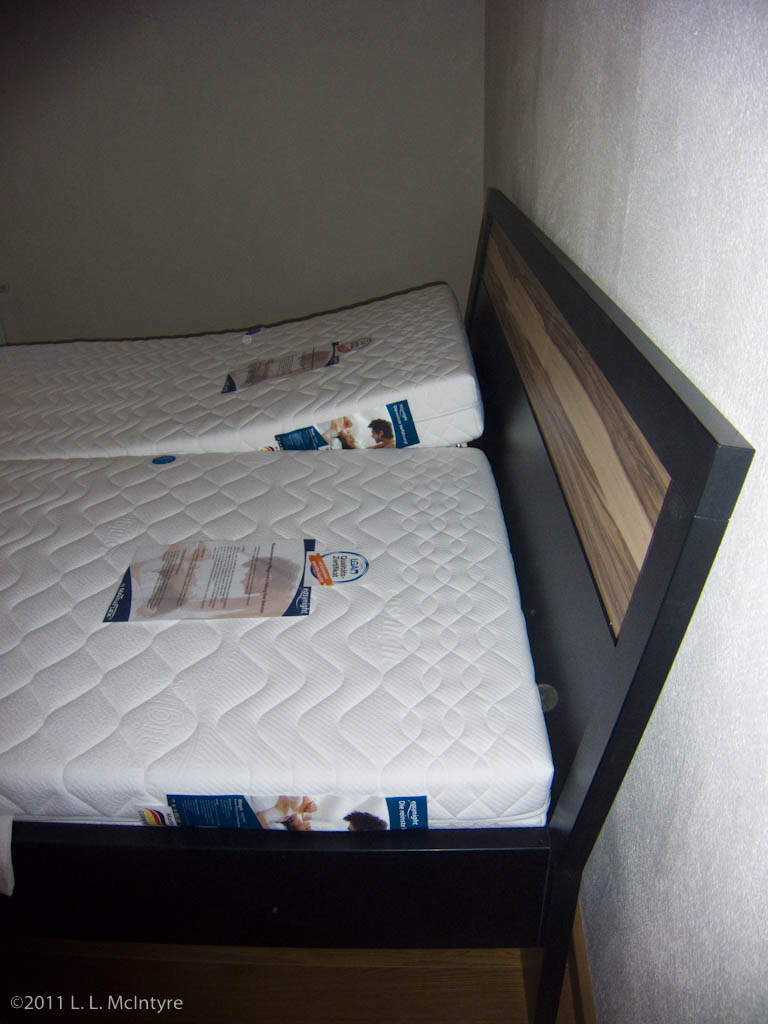So we quickly realized the key piece of furniture we needed to buy before we can move into the new apartment is a bed. There are a couple of big furniture stores in a neighboring town, and last Saturday, one of Chris’ new colleagues kindly gave us a ride out there. After spending a whole lot of time figuring out how to buy a bed, we did successfully purchase one — it was delivered yesterday.
I know that buying a bed may not seem like an outing that would led to an hours-long adventure in vocabulary, cultural norms, and furniture stores. But in fact, the way the beds work in Germany is vastly different from North America. I’m talking about both the “hardware” of the bed, as well as the sheets, etc. you use on top. Today’s post is all about the “hardware”, the physical pieces of the bed (as opposed to the bedding, i.e. sheets, pillows, etc.).
Truly, one of the interesting things about travelling the world and living abroad is getting to know the local norms and customs when it comes to all kinds of things. However, one of the complicated things about travelling the world and living abroad is figuring out how to ask the right questions to find the right pieces you need when trying to settle in and buy something like a bed.
The last time Chris and I purchased a bed frame, many years ago, we were sleeping on futons. The only complicated part then was that we wanted a flat futon frame for the bed, not a frame that would morph into a couch on demand. We couldn’t find one of those non-transforming ones at the time, so we had to have one specially made. But, to the best of my recollection, ordering a “frame” got you all the following parts, which were included as standard with the frame: the frame “body”, the slats to put the futon on, a headboard and a footboard. So, aside from having to special order the frame, we just ordered a “frame” back then.
Fast forward to last Saturday in Germany. Beds frames here are priced and sold in pieces; there’s nothing included with the frame. This makes things complicated to select a “frame”, since you have to separately select all the parts. The beds are displayed as all put together, though, so you have to realize that you need to choose each part individually, not something that was obvious to two people not familiar with this system of bedding.
While at the store, we needed to able to read the prices to see what how much each part of the frame cost, since things were very rarely priced as a complete unit. So, we needed to have a good idea of the vocabulary for all the essential parts:
1. You need the edge frame, called the Rahmen.
2. You need the Kopfbretter, the headboard.
3. You need the Matratzen, the mattresses. That’s not a typo, and I’m not talking about a box spring and mattress – for a bed the size of a queen-size bed in North America, you get 2 single-sized mattresses. That’s what you see in that photo.
4. You need the Latterosten, the part with the slats that you put the mattress on; in the following photo, one mattress has been flipped up to reveal the Latterosten underneath:
Just as there are two mattresses, there are two separate Latterosten pieces. In the set of photos you can see that we got slightly fancy Latterosten, which allow the head and the feet on each side to be raised separately, if you want.
Now, in terms of mastering the vocabulary for this particular shopping expedition, note that the word for mattresses in German sounds very similar to the corresponding word in English, so I didn’t have trouble remembering that one. And the word for headboard contains Kopf, “head”, a word I may have picked up from watching too many reruns of Hogan’s Heroes in my youth, so I that word was also easy to remember.
That left trying to remembering the words for the slats, Latterosten, and the word for outer frame itself, the Rahmen. Now I ask you, do those two terms not sound like a “roasted Italian coffee drink” and “Chinese noodles”, respectively? That’s how we remembered the terms when we were in the store. So, I just needed to look at the tags and find the prices for the roasted coffee and for the noodles. Simple, no?
You can tell I’m going to be fluent in German in no time at all. 😉





Funny, I can’t wait to hear how you order a couch which seems to have the same spelling. I wonder if it has the same spelling when you say “that concept seems to be couched in an impossible position. If buying a coucn I wonder if you have to buy the rahmen-noodles and the latterosten-coffee plus the upholstery-polster-as in gallup and the stuffing and cover and stuffed seat. Mein Gott! I am glad you are not going to buy a car. How about getting your hair done or a petticure/manicure. do they also have Vietnam women doing that. I can’t imagine Vietnamese with a German accent. This adventure of yours is going to be so fun. I like it.
I can’t envision sleeping on a mattress without a box spring. Yeah, I’ve slept on cots, air mattresses and beds without one. But it is more comfortable with the box spring atop the slats, then the mattress atop the box spring.
That’s the way things were done in the really good old days, I’m surprised they don’t have rope “slats.”
Hope it’s more comfortable than sleeping on real coffee beans and noodles.:)
Do the sheets fit each piece separately or can you get queen size sheets, two to a pack with two pillowcases or is this another exercise ala the bed parts.
Uh, Linda, exactly what is going on in that photo on the big labels?
Better you than me doing all of this! I get tired just hearing about all the running around you do and all the decisions you have to make!
Thanks for all the comments!
@Kathy – re the sofa, we’re going to try again this weekend to order a sofa (there was a problem with the first order). There was some debate the first time if we needed to pay for “setup” for the sofa; I’ll keepyou posted if it comes in a kit to do it yourself. (That’s a joke – I hope!)
@Mom – the beds we’ve had in the hotels and the vacation apartment have been quite comfortable, and fortunately don’t feel like you’re sleeping on noodles and coffee. 😉 Re the sheets, etc. – that’ll be the topic of blog post coming soon.
@Dovie – the big labels were just the labels on the mattresses, which the people who delivered and set up the bed didn’t take off. We have since taken them off. 😉
@Stan – you and Judie would probably be better at all the furniture decisions than we are, you’ve had more recent experience!
Sounds like bed-buying at IKEA. We bought the kids’ beds there some time ago. We wandered around the warehouse and picked out the bed frame, slats and mattresses (although maybe we bought the mattresses at another store).
Same thing with our shelves for the TV, etc. Everything was a separate component. DMC pieced it together on-line, then we bought everything separately and put it together.
So, if the bed frame, etc. is the hardware, that would make the sheets, etc. the software, right?